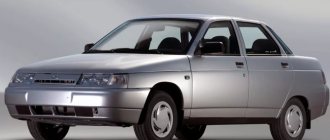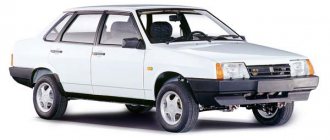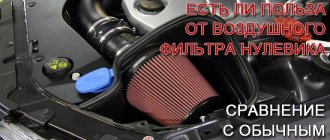VAZ 2104 diesel
Diesel power plants are not typical for the domestic automobile industry. Therefore, the appearance of the VAZ 2104 with a diesel engine became a sensation. However, how successful can this modification be considered?
The VAZ 2104 was equipped with a VAZ-341 vortex chamber diesel engine. The engine was produced at the domestic enterprise JSC Barnaultransmash. Because of this device, AvtoVAZ engineers slightly changed the design of the car itself:
- installed a five-speed gearbox;
- connected a high-power radiator;
- increased the battery capacity to 62 Ah;
- developed a new form of starter;
- modified front suspension springs;
- increased sound insulation of the cabin.
At the same time, in practice, thanks to the use of a diesel unit, it was possible to significantly reduce fuel consumption, when, in all other respects, the diesel VAZ 2104 was in no way inferior to the gasoline one.
The diesel version has become significantly more economical than the gasoline version
The history of the VAZ diesel engine
The VAZ 2104 was first produced in Tolyatti in 1999. Initially, it was planned to equip the car with a more powerful 1.8-liter power unit, but this idea was never realized.
The new VAZ-341 diesel engine was characterized by high cost and reduced power. And even taking into account the low price of diesel fuel in 1999, the feasibility of such a modification was questioned by experts.
Diesel power unit 52 hp. fits perfectly into the design of the “four”
The VAZ-341 diesel engine was created in 1983. In fact, the new model was the result of modernization of the “three” engine. Engineers have significantly strengthened the existing cylinder block and piston stroke ratio. Due to many minor modifications, the VAZ-341 engine first began to be tested on cars only at the end of the 1999s.
Specifications
The engine on the VAZ 2104 (diesel version) consists of four cylinders arranged in a row. Engine displacement is 1.52 liters. As mentioned earlier, there were initially plans to install a 1.8 liter engine, but the tests failed. The power of the unit is only 52 horsepower. Initially, the diesel version of the VAZ 2104 was designed for beginners and leisurely drivers.
Low-power motor designed for city driving
The engine uses a liquid cooling system to operate.
An important difference from a gasoline installation is the additional equipment with a high-power starter and a modified block of glow plugs. This is necessary to ensure that the engine starts quickly in winter.
Thus, the VAZ-341 cannot be called a powerful power plant. However, it is precisely because of this that the car received the title of one of the most economical in the VAZ line: fuel consumption on the highway is only 5.8 liters, in an urban environment - 6.7 liters. Considering the low prices for diesel fuel at the turn of the 2000s, we can say that operating the model was not expensive.
The acceleration time to 100 km/h for the leisurely diesel VAZ 2104 is 23 seconds.
Manufacturers have also indicated the service life of the diesel engine - it requires major repairs every 150 thousand kilometers.
Even by modern standards, the thrust of the diesel “four” makes it competitive with many domestic and foreign brands
Specifications
| Manufacturer | Autoconcern "AvtoVAZ" |
| Start year of release | 1984 |
| Volume, cm³ | 1452 |
| Power, l. With | 53 |
| Torque, Nm | 96 |
| Compression ratio | 23 |
| Cylinder block | cast iron |
| Number of cylinders | 4 |
| cylinder head | aluminum |
| Cylinder diameter, mm | 76 |
| Piston stroke, mm | 84 |
| Timing drive | belt |
| Number of valves per cylinder | 2 SOHC) |
| Turbocharging | No |
| Hydraulic compensators | No |
| Valve timing regulator | No |
| Lubrication system capacity, l | 3.75 |
| Oil consumption (calculated), l/1000 km | 0.6 |
| Fuel supply system | direct injection |
| Fuel | diesel |
| Environmental standards | Euro 2 |
| Resource, thousand km | 125 |
| Weight, kg | 130 |
| Location | longitudinal |
Advantages of the VAZ-341 diesel engine
Why did manufacturers need to experiment with VAZ 2104 engines? The race among automakers at the turn of the 20th - 21st centuries led to the need for new modifications and developments in order to win “their” segment of buyers.
The main advantage of the diesel VAZ 2104 is its low fuel consumption, which, with minimal fuel prices, makes the car the most budget-friendly in the manufacturer’s line-up.
The second advantage of the model can be considered its reliability - the diesel engine and reinforced components made the car with increased performance. Accordingly, the owners did not need frequent repairs and specialized maintenance as needed to be done on the gasoline versions of the Four.
And the third advantage of the VAZ 2104 is the high engine thrust, even with a power of 52 horsepower. Therefore, the car is being purchased very actively:
- for country transportation;
- for use in large families;
- those who like to travel in large groups.
The model’s universal body is designed for cargo transportation, and with a diesel engine, the traction of a loaded vehicle increases significantly
And, of course, the VAZ-341 diesel engine can withstand Russian frosts perfectly. For example, the set temperature for a cold engine start is possible even at a temperature of minus 25 degrees. This advantage is very important for Russian drivers of all categories.
Reliability, weaknesses, maintainability
Reliability
The reliability of the VAZ-341 increased with the duration of its production. The first batches of the unit had many defects. Accordingly, the mileage resource was extremely low - only 30-40 thousand km.
The piston group was especially low in reliability. Repeated improvements to the design of the unit led to a significant improvement in technical and operational characteristics.
For example, in the first batches of the engine, increased wear of the piston ring grooves was observed. The manufacturer eliminated this problem by strengthening the grooves by remelting the area in contact with the ring.
where: dark area – strengthening remelting. Its minimal dimensions led to groove wear. Increasing the remelting zone (shown by the dotted line) permanently eliminated the piston from the defect.
The increase in reliability was facilitated by the modernization of the crankcase ventilation system. On the first engines, as a result of its imperfection, oil penetrated into the air filter and coated it with oil, nullifying the work of the air filter. After modification, the crankcase ventilation system operates according to a different scheme, bypassing the air filter.
One of the main indicators of the reliability of any engine is its service life between overhauls. The manufacturer determined it at 125 thousand km. In practice, it is exceeded many times over. As tarella from Efremov says on one of the forums: “... do not skimp on oil and then the engine will work for a long time...”.
In 2000, the testing group of the Za Rulem magazine tested the VAZ-341 after driving 125 thousand km at the Barnaul plant.
After complete disassembly of the unit and thorough diagnostics of each component, the result was stunning - the engine was in excellent condition. Even on the cylinder walls the hon. The crankshaft and CPG retained the drawing dimensional tolerances, i.e. they had almost no wear.
Thus, following the rules and recommendations of the manufacturer for the operation and maintenance of the engine, we can safely conclude that the VAZ-341 is a completely reliable power unit.
Weak spots
They did not bypass the VAZ-341 either. But we must immediately make a reservation: during operation they were identified, and the manufacturer immediately began to look for ways to eliminate them.
Engine overheating. The main reason was a cylinder head gasket failure. The culprits of the malfunction turned out to be the head bolts. Previously, they were unified with existing gasoline internal combustion engines.
But, as it turned out, they were absolutely unsuitable for diesel engines - weak. By replacing them with reinforced diesel ones, the problem of gasket failure was successfully solved.
Gasket and reinforced cylinder head bolt (right)
Overheating could be caused by a weak bearing assembly of the water pump and a not always high-quality thermostat.
Vibration. This phenomenon accompanies almost any diesel engine.
Increased noise level when the engine is running. Also an “accessory” of a diesel engine. Considering the simplicity of the engine design and the budget performance of the car, we had to put up with these shortcomings.
Difficulty starting the engine at temperatures below -20˚C. Later, this problem was successfully solved.
Well, perhaps, another common detail that causes general dissatisfaction among all car owners is the low engine power.
The manufacturer has not avoided this drawback. Subsequent modifications, created on the basis of the VAZ-341, became more powerful.
Disadvantages of the VAZ-341 diesel engine
Owners of diesel versions of the VAZ 2104 note several shortcomings of their cars:
- Difficulty in repairing the fuel system. Indeed, the use of low-quality fuel or neglect of the required level of maintenance quickly leads to the fact that the fuel injection pump fails. Its repair is possible only in specialized auto repair shops and is not cheap.
- When the timing belt breaks, the valves bend. That is, in case of an ordinary breakdown, you also have to spend money on buying new valves and adjusting them.
- High price. For all their efficiency in operation, VAZ 2104 diesel models are much more expensive than gasoline ones.
Valves are considered the weakest point of the model
Reasons for failure
Mass production of diesel passenger cars could not be established for several reasons. The main one is the unprofitability of producing such motors due to the significantly outdated design. The engines had the same pre-chamber design as the first 341st prototype, and were significantly behind modern analogues in terms of performance and environmental friendliness. To achieve acceptable performance, it was necessary to create a motor of a different design. Independent development was considered unprofitable, and there were no technical partners for this. In addition, VAZ products sold well even without diesel.
Change of oil
Perhaps the most common and frequently performed repair operation is changing the oil and oil filter. Consider the sequence of actions:
- Before starting repair and restoration operations, you should remove the negative terminal from the battery.
- If there is engine protection, it must be removed. To do this, you need to unscrew the mounting bolts.
- Next, unscrew the drain plug, which is located on the pan, and wait for the lubricant to drain.
- We tighten the drain plug, while not forgetting to change the copper sealing gasket.
- Using a special puller, remove the oil filter. Before installing a new one, you need to pour 100 grams of new oil into it.
- Unscrew the filler neck and pour in the oil.
- After tightening the filler plug, start the engine and let it run for a few minutes.
- If necessary, add a little to the required level, which can be seen on the dipstick.
Thus, the oil change is considered complete. If the type of lubricant changes, the engine must be flushed.
Latest experiments
In 2007, Tema Plus installed an FNM engine on Chevrolet Niva for individual orders.
In 2014, on Lada 4x4 they experimented with 1.3 l 75 l. With. Fiat Multijet engine. However, it was not compatible with either the transmission due to torque limitations, or with the analog wiring diagram due to the CAN bus.
Super-auto explored the possibility of installing a 4x4 1.5 liter diesel engine from Renault Duster on the Lada 4x4 by 2015. In addition, an experimental car was created with a 100-horsepower 1.8 liter engine.
Peculiarities
The diesel station wagon differs in some design features from the gasoline VAZ-2104. Due to the greater mass, the diesel engine required the installation of reinforced front suspension springs. The main pair was replaced from 4.1 to 3.9. To compensate for the increased noise level from the diesel engine, additional sound insulation was installed in the engine compartment (on the hood and crankcase protection). The exhaust pipe was wrapped in a loop to prevent soot from contaminating the right canopy. An indicator for heating the glow plugs and a button for heating the fuel filter appeared on the dashboard (but there is no indicator for its activation).
Reviews
Having “promoted” the so-called “Fiat” models, the “kopek” and the VAZ-2103 , to the required level, VAZ first slightly modernized the first one, releasing a modification of the VAZ-21011 , and then really began developing their own models - the all-wheel drive Niva, the “super-luxury” VAZ 2106 , as well as products of deeper intervention in the Fiat platform - we are talking about the “five” and VAZ-2107 . Let's not forget that by the beginning of the eighties, a fundamentally new model was almost completely ready - the first front-wheel drive hatchback VAZ-2108 . Thus, almost the entire model range was thoroughly shaken up for the new decade. And only the VAZ-2102 station wagon was produced without any special changes, although the base model 2101 was noticeably outdated by that time. There was no point in upgrading it “to level zero eleven” - the absence of fangs on the bumpers and a different number of vertical slats on the radiator grille would hardly have made the “kopeck piece” more modern. The conclusion suggested itself: the new station wagon model had to be produced on the basis of the most modern Zhiguli of the fifth family.
Service
Servicing VAZ engines, which are classified as “classics”, is quite simple, since the structure is the same, only the volume changes. According to the technical documentation, the service standard is 10,000 km. After this mileage, the engine needs to replace the lubricant and filter element.
In addition to standard maintenance procedures, other elements also change depending on the mileage. So, every 20,000 km the air filter is changed. Upon expiration. 40,000 km it is necessary to replace the gas distribution mechanism kit.
If the replacement is not done in a timely manner, the belt (or chain) may break, which will cause bent valves, and even worse, bending of the cylinder head or other consequences that will lead to premature overhaul.
Replacing the water pump
Another operation that motorists perform on classic engines is replacing the water pump. It is carried out mainly due to a faulty drive shaft bearing or when the gap increases and the water pump begins to leak. So, let's consider the sequence of actions aimed at troubleshooting:
- We dismantle the minus terminal of the battery.
- In order to dismantle the water pump, the drive belt must be removed. Depending on the design features, it can be connected to a common system or driven separately.
- The next step is to drain the coolant. To do this, you need to unscrew the radiator drain plug, first replacing the container. You can also drain the coolant using the drain hole on the block.
When replacing the pump, it is recommended to replace the coolant in the engine. It also has its own resource of use, and also gets dirty.
- Once all the coolant has been drained, you can begin replacing the water pump. Depending on the configuration, this unit can be secured with 3 or 5 bolts, which must be unscrewed, and then gently pull the product towards you.
- Installation is carried out in reverse order. At the same time, do not forget that it is necessary to change the gasket, which should come with the new pump.
- Pour coolant into the engine and start the car. Since there is air in the system, it must be removed from there. First, you should bleed the upper pipe and try to remove the maximum amount of air. The remaining amount will come out when the engine runs a little and circulation takes place. After the engine has been running, it is worth adding the coolant to the required level.
Conclusion
The VAZ 2104 engine, or rather the modifications of AvtoVAZ power units that were installed on this car, are similar in technical characteristics, only during the development process the type of injection, volume and power changed.
As for service, it is typical and typical for all classic models. You can repair the engine with your own hands, without resorting to the services of a car service, which, in principle, is what most motorists do.
The domestic automobile industry is represented by many different models. However, in the history of AvtoVAZ there is one modification that even today causes the most controversial reviews. This is a VAZ 2104 equipped with a diesel power plant. Why was such an engineering move needed? Was it possible to create a car with clearer characteristics and power? What do the owners themselves think about the diesel version of the Four?
Breakdowns
But despite all the advantages, the VAZ 341 diesel engine also has a sufficient number of disadvantages and common breakdowns that owners of cars with it under the hood encounter. But most of them are already known, so they can be eliminated quite simply. The most common engine problems are as follows:
- The engine may simply refuse to start, and this may be due to several factors. The engine may simply not gain speed, then it is worth inspecting the tips of the wires that power the starter. If they oxidize, they should be cleaned. It is also worth checking the charging status of the battery and the functionality of the starter.
- The engine may stall immediately after it starts. This can happen for two reasons. The most common occurrence is a clogged fuel filter, which can be eliminated by replacing it. The fuel filter heater may break, which can also be replaced.
- The motor may not operate at maximum power. Most likely the cause is air getting into the fuel line. This can be eliminated by removing the rubber plug from the injector of the 4th cylinder, and then using your hands to pump the fuel pump. This is done until gasoline flows out from there without air bubbles. Then the plug must be returned to its place.
- The injector may knock and the engine will run quite harshly. The characteristics of the VAZ 341 diesel engine are such that the cause of such a breakdown may be that the heating valve of the high-pressure fuel pump freezes. You will have to disassemble the nozzle and wash everything, and if necessary, replace the atomizer. When the engine starts to work hard, only one of the cylinders turns off, then the reason for this is the heating valve. It needs to be dismantled and washed, and if it is broken, replaced.
Niva.
VAZ Niva
At one time, the domestic manufacturer equipped the not little-known Niva with a diesel engine. The first diesel Niva VAZ was released with a domestic engine. This vehicle model had an engine displacement of one and a half liters and was equipped with a turbine. As a result, the model that came off the production line was not powerful enough. Since the domestic manufacturer produced the Niva to overcome difficult sections of the road, the engine power had to meet certain parameters. The domestically produced diesel engine could not cope with difficult sections of the road route and the manufacturer decided to increase the engine displacement. Further, cars with a volume of one point nine liters rolled off the assembly line of the Volga Automobile Plant. These diesel modernizations were installed on both three-door and five-door Niva. This engine model remained experimental and was not included in mass production.
After this, the manufacturer began to equip the domestic Niva with a foreign engine. The Peugeot diesel engine began to be serially installed on Russian cars. Engines from foreign manufacturers were more powerful and fully met the needs of domestic car enthusiasts. The Niva became more economical and fuel consumption met the required standards. Of course, after a diesel engine was installed on the Niva, the vehicle did not become more dynamic. The manufacturer set a speed limit of 120 kilometers per hour. In practice, a domestic car with a foreign engine reached a speed of 100 kilometers per hour only after a quarter of a minute. Some cars of this modernization can still be found on domestic roads. Moreover, most of the cars that have survived to this day are re-exported.
You can also often find a Niva with a self-installed diesel engine. Due to the efficiency of diesel, domestic car enthusiasts sometimes installed the engine with their own hands or in professional workshops. In most cases, the same engine from the Peugeot plant is installed on the Niva. This motor is the easiest to install in a vehicle system, since the points of contact with the body are completely similar to a gasoline engine. As you know, with such a modernization of a machine, replacing the engine alone is not enough. Along with replacing the motor, you have to disassemble the transmission and install a new gearbox. Most often, instead of a gearbox from a domestic manufacturer, a Fiat factory gearbox was installed. Accordingly, along with the modernization of the transmission, it was necessary to completely change the clutch housing. To optimize the operating temperature of the engine system, the craftsmen had to equip the vehicle with a GAZ radiator.
It is necessary to understand that modernization of the propulsion system requires appropriate registration with the traffic police!
Reviews
Based on the test results, it was confirmed that it is unacceptable to use standard “gasoline” spare parts. The VAZ diesel engine, like other engines of this type, is characterized by increased loads due to a higher compression ratio. Because of this, many elements lacked strength, especially the crank mechanism and the piston group. The situation was aggravated by low manufacturing accuracy.
Engine characteristics
Over the years, the VAZ 2104 was equipped with power units of different power: from 53 to 74 horsepower (1.3, 1.5, 1.6 and 1.8 liters). Two modifications (21048D and 21045D) used diesel fuel, but all other versions of the “four” consumed AI-92 gasoline.
The model was equipped exclusively with carburetor units
Depending on the engine power, fuel consumption also varies.











